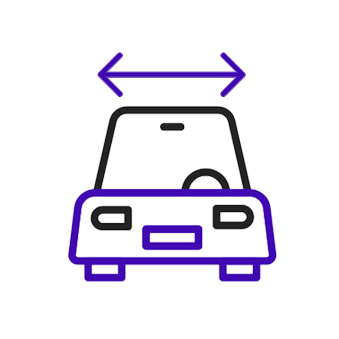
Ever wondered how to handle blue lights? Picture this… You’re driving along, radio blasting, thinking about dinner plans, and then—BAM—blue lights appear in your rear view mirror. Suddenly, you’re not in an action movie, but your heart’s racing like you are. What do you do? Slam on the brakes? Mount the kerb? Pretend it’s not happening? (Spoiler: none of these). Let’s break it down so you can stay safe, legal, and helpful when blue lights make an appearance.
Blue Lights 101: Why It Matters
When blue lights appear, time is everything. Emergency services rely on us to react quickly—but also safely. Whether it’s an ambulance, fire engine, or police car, the goal is simple: make their journey as smooth as possible without putting anyone at risk.
But let’s be clear: responding to blue lights doesn’t mean breaking the law or risking an accident—because let’s face it, the last thing they need is to send another ambulance out for us! It’s all about staying calm, using common sense, and giving emergency vehicles the space they need.
What to Do When Blue Lights Are Behind You
When blue lights pop up in your rearview mirror, here’s the game plan:
Keep your cool and assess where the vehicle is. Use your mirrors to understand their position—are they behind you or approaching from another lane?
Use your indicators to show you’re preparing to pull over or adjust your position. Predictable movements are key.
Find a safe spot to pull over, such as a straight section of road. Avoid stopping on bends, hill crests, or directly opposite other vehicles where space is tight.
Sudden stops can confuse the emergency driver and create a hazard for vehicles behind you. Slow down gradually and keep it smooth.
Video: Blue Light Aware
What About Red Lights?
This one’s tricky and commonly misunderstood. Here’s the lowdown:
Can You Go Through a Red Light?
No. Running a red light is still illegal—even if you’re trying to help. Moving aside within your lane is fine, but crossing the stop line is a big no-no. You could be fined, receive points on your licence, or worse, cause an accident.
What Should You Do?
If you’re first in the queue, stay put unless there’s room to move forward safely without crossing the stop line. The emergency vehicle will either navigate around you or wait.
Video: Blue Light Aware
Motorways and Dual Carriageways
High-speed roads can make blue-light responses more complex, but the principles remain the same:
– Stick to your lane unless you can safely move over.
– Never stop in a live lane.
– Create space by easing into the left-hand lane or hard shoulder, if safe.
Hearing Sirens but Not Seeing Lights?
We’ve all been there—siren blaring, but no flashing lights in sight. What now?
Stay Alert and Look Ahead
Emergency vehicles might be on a crossroad or behind another car. Check your mirrors and scan your surroundings.
Keep Moving
Don’t stop dead in the middle of the road. Maintain a steady speed until you can safely pull over or identify the vehicle’s path.
Common Mistakes to Avoid
Mounting Kerbs or Verges
This risks damaging your car and creating obstacles for pedestrians.
Blocking Junctions
Don’t stop in box junctions or block access roads—it just makes things harder.
Stopping Opposite Other Vehicles
Narrowing the road could trap the emergency vehicle.
Understanding “Effective Non-Use”
Ever noticed the siren suddenly stops but the lights stay on? This is called “effective non-use,” and it means:
“I’d like to get through, but I’ll wait for a safe moment.”
In these cases, don’t panic. Keep driving until a clear opportunity arises.
Why Blue Light Awareness Matters
– Emergency responders face delays daily because of poor driver reactions.
– Helping them reach their destination safely could literally save lives.
– By staying informed and practicing good driving habits, you’re playing your part in keeping the roads safe.
Learn More with Blue Light Aware
If you’re still unsure about how to handle blue lights in specific situations, the team at Blue Light Aware has put together some fantastic videos demonstrating real-life scenarios. These short clips provide clear, practical examples of what to do (and what not to do) when emergency vehicles approach. Whether it’s navigating red lights, motorways, or tight urban streets, their videos are a great way to build your confidence and awareness.
FAQs
Q: What should I do if I’m on a bend or hill when blue lights appear?
A: Drive on until you reach a straight section with good visibility, then pull over safely.
Q: Can I stop in a bus lane for an emergency vehicle?
A: Yes, if it’s safe to do so and helps clear the way.
Q: What happens if I don’t move for an emergency vehicle?
A: Not making reasonable efforts to give way could be considered obstructing emergency services, which may lead to fines or other penalties.
Q: What if I hear a siren but can’t tell where it’s coming from?
A: Stay calm, keep driving at a safe speed, and check your mirrors until you can identify the source.
Q: Should I pull over immediately?
A: Not always. If the spot is unsafe (e.g., narrow roads, bends), keep driving until a better option appears.
Q: Can I go through a red light to let an emergency vehicle pass?
A: No, it’s illegal to cross a red light, even for emergency vehicles. Stay put unless there’s space to move forward safely without crossing the stop line. Emergency drivers are trained to navigate around you if needed.
Stay Safe, Stay Smart
Dealing with blue lights isn’t about rushing or panicking—it’s about staying calm, using common sense, and keeping everyone safe. Emergency drivers appreciate thoughtful, predictable reactions far more than dramatic ones. Next time you see those flashing lights, you’ll know exactly what to do.















